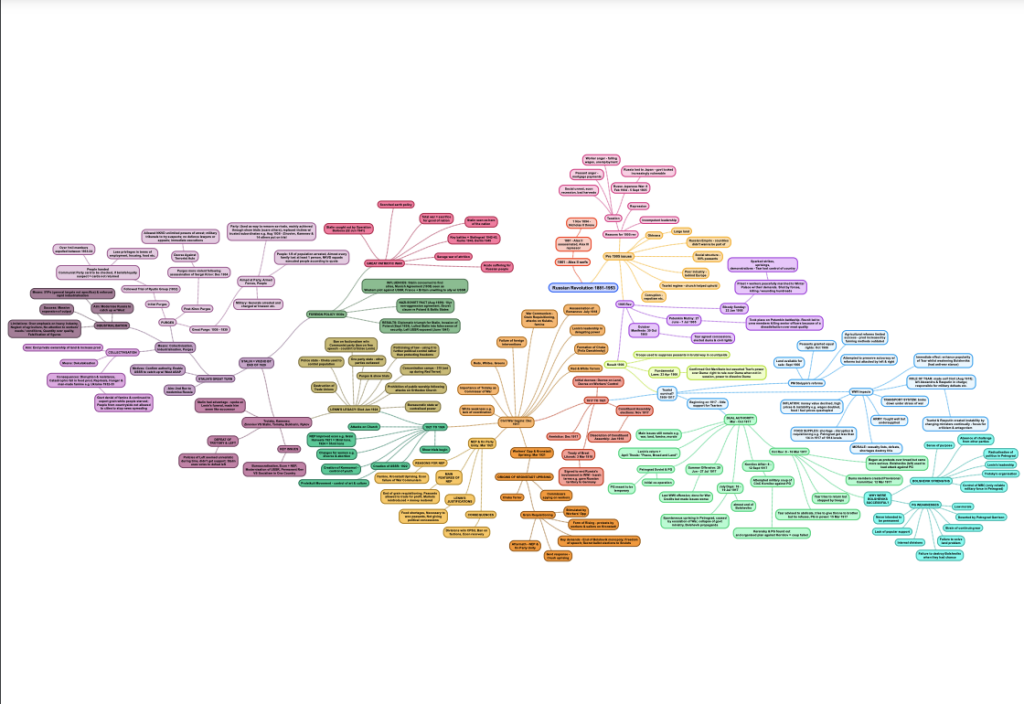Russian Revolution Summary Mind Map
Summary:
Russian Revolution (1881-1953) Summary:
Pre-Revolutionary Period:
- 1861: Alexander II emancipates the serfs.
- 1881: Alexander II is assassinated; Alexander III becomes a repressive ruler.
- 1894: Nicholas II takes the throne.
- Issues: Large Russian Empire with countries resistant to Russian rule; 80% peasants in social structure; lagging industry; church upholds the Tsarist regime; corruption prevalent.
1905 Revolution:
- Reasons: Repression, heavy taxation, social unrest, economic downturns, Russo-Japanese War loss, and more.
- Bloody Sunday (22 Jan 1905): Peaceful marchers shot at Winter Palace, sparking nationwide unrest.
- October Manifesto (30 Oct 1905): Tsar promises reforms, including a duma & civil rights.
- Potemkin Mutiny (1905): Revolt over dissatisfaction with senior officers.
- By 1906, troops brutally suppress peasant uprisings. Fundamental Laws further secure the Tsar’s power.
The Road to the 1917 Revolution:
- PM Stolypin’s reforms attempt to preserve autocracy.
- WWI impacts: initially boosts Tsar’s popularity but leads to economic issues, food shortages, and morale declines.
- Dual Authority (Mar-Oct 1917): A power struggle between Petrograd Soviet & Provisional Government (PG).
- Lenin’s April Thesis promotes “Peace, Bread, and Land”.
- October Revolution (1917): Bolsheviks gain momentum against PG.
- Tsar abdicates in March 1917.
Bolshevik Era:
- Bolshevik strengths: Clear mission, leadership of Lenin & Trotsky, and control of MRC.
- PG weaknesses: Lack of support and internal divisions.
- Key events: Summer Offensive, July Days uprising, Kornilov Affair.
- Civil War: Reds (Bolsheviks) vs. Whites & Greens; the importance of Trotsky, Lenin’s leadership, and policies like War Communism.
- 1918: Romanov family assassinated.
- Kronstadt Uprising (1921): Major protest crushed by the Bolsheviks.
- New Economic Policy (NEP) was introduced.
Stalin Era:
- 1924: Lenin dies, leaving a centralized, one-party state legacy.
- Power struggle: Trotsky and Allies vs. Stalin and Allies; Stalin emerges as dominant by 1929.
- Stalin’s policies: Collectivization, rapid industrialization (Five-Year Plans), and purges targeting party members, the military, and the general populace.
- Foreign Policy in the 1930s: USSR seeks allies against rising Nazi Germany, resulting in the Nazi-Soviet Pact.
- WWII (Great Patriotic War): USSR was initially caught off guard by the Nazi invasion, but key battles turned the tide.
Excerpt:
Russian Revolution Summary Mind Map
This summary provides an overview of the complex series of events that span the Russian Revolution and its aftermath, from the late Tsarist era to the height of Stalin’s reign.


Reviews